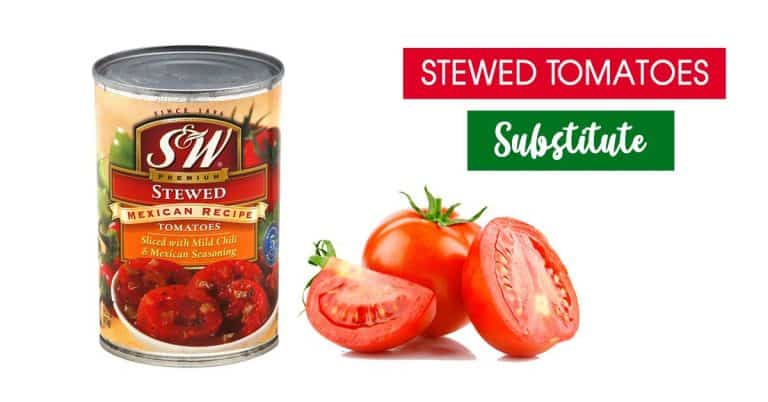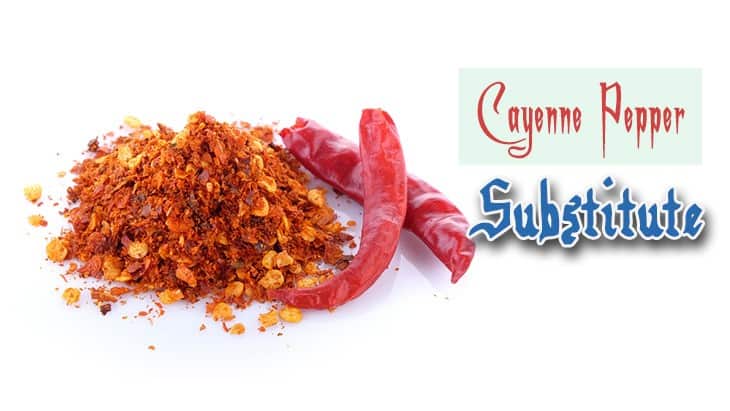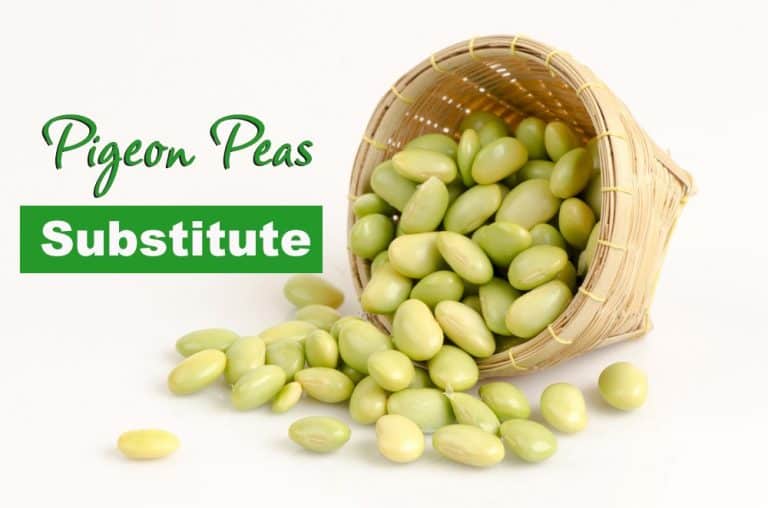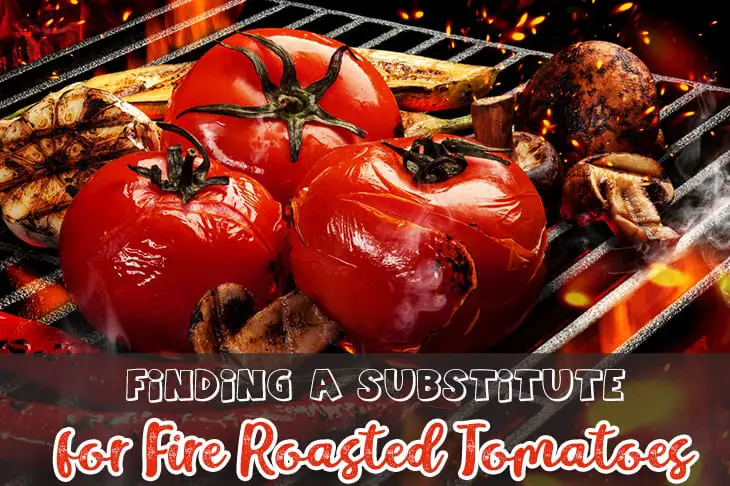
As great as they are, sometimes you need a substitute for fire roasted tomatoes. Perhaps it’s because canned fire roasted tomatoes are sold out in your local grocery, or you’re not confident in your roasting skill.
Fire-roasted tomatoes are among the easiest ways to add a smoky flavor. They can bring the best out of common recipes, making them less bland and turn into something you will remember for a long time, especially when they’ve been enhanced with garlic powder and onion.
Read on to find out what replacements can bring a similar flavor to your dishes.
Here is a quick rundown of ingredients that can be used in place of fire roasted tomatoes. Some of them are pretty straightforward (other forms of tomatoes), while others might be less familiar to you (tamarind paste).
8 Best Substitutes for Fire Roasted Tomatoes
1. Diced Tomatoes
This alternative is the most straightforward solution when you have no time for roasting tomatoes. The main difference between diced fresh tomatoes and fired roasted ones is whether they have been cooked to a certain degree.
Just grab some fresh tomatoes from your fridge and use a sharp straight-edged knife to cut them into even cubes.
However, diced tomatoes aren’t always the best one-for-one replacement. Skip them if the smokey smell, the taste of burned vegetables like fire roasted tomatoes, or enhancements like garlic powder is what you’re going after.
Even though the consistency of the final product may remain the same, it may lack some complexity and depth.
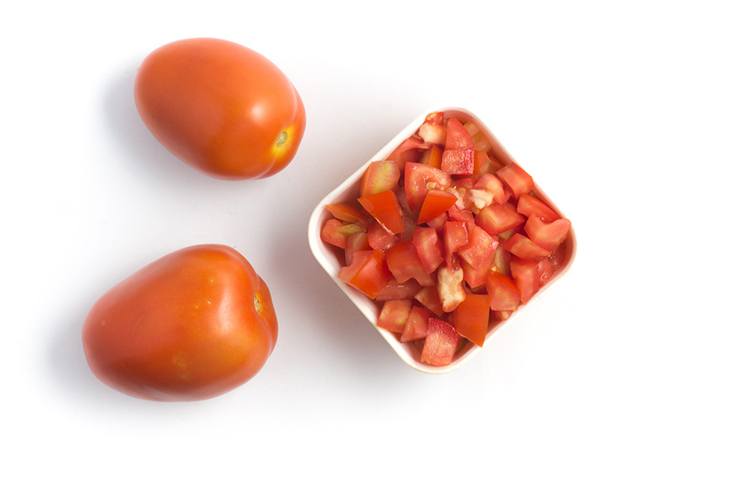
There is a lot of water inside uncooked tomatoes, which can make your dishes watery or soggy if you don’t serve them right away.
Diced tomatoes are also a challenge when it comes to storage. If not done properly, commercial diced tomatoes have to be processed before getting on the shelf, and homemade ones are best for eating on the same day.
Nonetheless, diced fresh tomatoes can still be a decent stand-in for fire roasted tomatoes on some occasions. If you prefer distinct chunks of tomatoes and don’t mind the lack of smokey flavor, these pieces of tomatoes have a place in many creamy soups, casseroles, pizza sauce toppings, and sausage stews.
As there is no cooking or any complicated food processing involved, diced tomatoes retain the same fresh flavor and simple texture.
And the same thing is also true for its nutrient contents. Diced tomatoes are an affordable dietary source of vitamin K, vitamin C, folate, potassium, and an antioxidant called lycopene. They have been known for many health benefits, including reducing the risk of cancer and heart disease.
To speed up the chopping, you may want to place tomato slices stacked on top of each other. The final chunks will also come away with better shapes if you can evenly space your cuts.
2. Crushed Tomatoes
The texture of crushed tomatoes is somewhere between those of tomato sauce and diced tomatoes.
Even though you can do it at home, most people get cans of crushed tomatoes from the stores, where they are sold as a mix of tomato paste or puree and fresh crushed tomatoes. They can come in handy if you have no fire roasted tomatoes, though this substitute may lead to some differences.
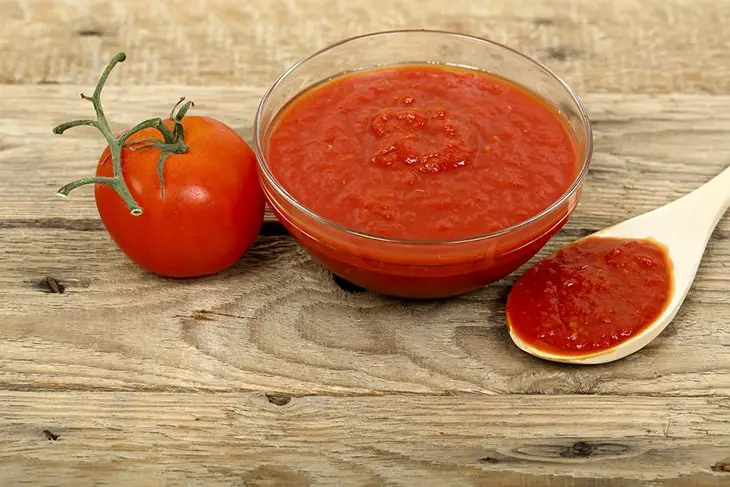
People usually use whole or diced tomatoes for roasting, so the biggest change here is the consistency and texture of your recipe. Canned crushed tomatoes may have gone through some processing, including removing much of the water content, but their sweetness and flavor can’t still come close to that of roasted tomatoes.
However, crushed tomatoes are not the worse choice. With the help of some particular spices, you can mimic the flavor of fire roasted tomatoes in one way or another.
Nutrients like vitamin C, vitamin K, minerals, and especially lycopene are still present. When buying canned tomatoes, check the label for this information. If you don’t want to have seeds or skins in your homemade crushed tomatoes, boil them first so the skins could be peeled off easier.
The range of recipes compatible with crushed tomatoes isn’t bad either. You can add them into countless things in place of roasted tomatoes, from lasagna, soups to salsa and everything in between.
3. Sun-dried Tomatoes

Sun-dried tomatoes offer another option if you want to experiment with something new with your recipe. You can buy them in stores, where they are available dry-packed or submerged in oil in a jar.
The tomatoes in those packages have been dried under the sun. But the process is more complex than just that. To keep the nutrients and the freshness of tomatoes, the manufacturers usually marinate them in salt or sulfur dioxide. This food preservation process results in a shrunken and wrinkled appearance.
Dried tomatoes have a crunchy texture and a tart, salty flavor without any smoky taste of roasted tomatoes. So if this burned taste is a must, you’d have a better chance with other substitutes on this list.
Smooth sauces are another thing sun-dried tomatoes may let you down. The results may be too flaky and crumbly as there isn’t much juice and water left in those dried tomatoes.
However, you still have plenty of choices with sun-dried tomatoes. You can add them in burgers, chicken breast, pizzas, pasta, and salads. One of the advantages of sun-dried tomatoes is they can last for a long time, up to several months, once opened.
4. Tomato Puree
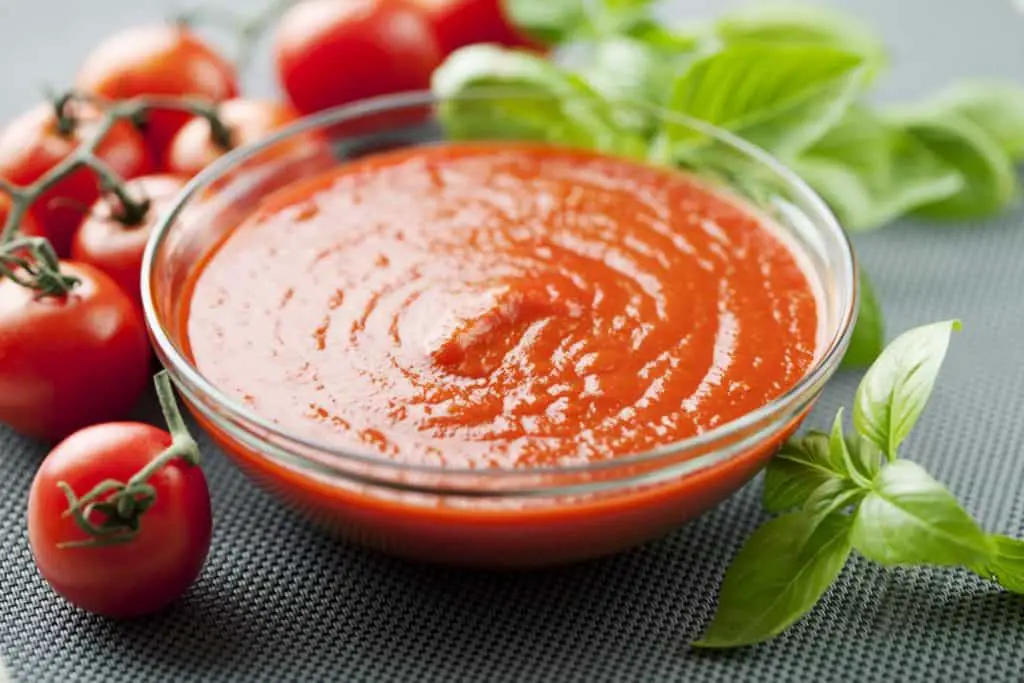
Tomato puree is the kind of thick liquid made by cooking and straining fresh tomatoes. The main difference between pureed tomatoes and tomato sauce or tomato paste is the consistency. The puree has a much deeper flavor and thicker consistency than tomato sauce but doesn’t reach the thickness of tomato paste.
Nonetheless, tomato puree and tomato paste are both decent substitutes for fire roasted tomatoes in recipes such as roasted eggplant and tomato pasta sauce. They’re a good choice when the crunchy texture is not your top priority or when you can add tomato chunks to make up for this.
Pureed tomatoes are available in lots of stores, where they are sold in cans as processed foods. If you have time, however, homemade fresh tomato puree always tastes better. It can be stored in airtight containers for up to a few months.
This alternative works very well with pizzas and pasta, especially when your oven stops working and you can’t use it to roast tomatoes. Other recipes this puree traditionally shines in include chicken or beef stews and many kinds of sauces and soup dishes.
5. Tomato Paste
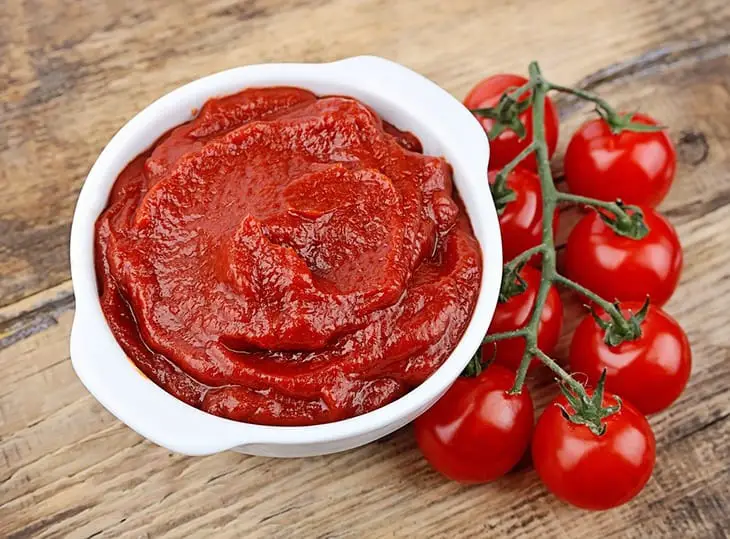
Compared to the tomato puree, the paste of tomatoes has a more concentrated and thicker texture. Often sold in tubes and cans, tomato paste is your best bet when you need to intensify the natural umami flavor of your recipe.
In Indian dishes, tomato paste is a cheaper alternative to fire roasted tomatoes as it enables a distinct flavor without cooking down fresh tomatoes. With this replacement on hand, you can also add depth to your pasta sauce with the additional help of olive oil and herbs.
Saucy meats and stews are other dishes commonly featuring tomato paste. If you already get that crunchy texture and smoky smell from other sautéd vegetables and only want additional tomato flavor and color, some squeezes of sundried tomato paste will do the job.
Tomato paste can be found pretty much everywhere, just like all kinds of canned tomatoes. It’s an affordable substitute that is easy to store and doesn’t require a huge amount to reach the desired flavor.
However, note that like tomato puree, tomato paste can’t provide the same texture as tomatoes that have been roasted above the fire. The best it can do is add color and a strong tomato flavor into your dish when you’ve run out of other options.
6. Tamarind Paste
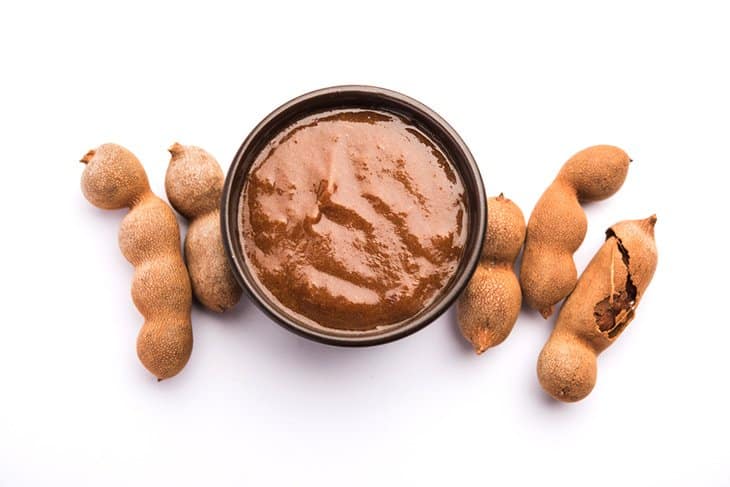
In relished and Indian dishes like chutneys, tamarind paste can be used to replace fire roasted tomatoes, thanks to the similar sour tastes they bring. Made from the dark, sticky, and sour fruit of tamarind trees, the paste is an ingredient in both desserts and savory dishes, especially in Thai cuisine.
Even though tamarind trees are native to Asian countries, tamarind paste has been popularized and can now be found in several stores in the US, particularly Indian and East Asian grocers.
If you want to mimic the sour and sweet tang, give it a try as a substitute for fire roasted tomatoes. Remember that it can’t help you with the texture, and you will have to adjust the ratio of sweetener and tamarind paste to reach your desired flavor.
Tamarind paste has a high content of vitamin C, many B vitamins, phosphorus, iron, and potassium. In Asia, it’s also often used to alleviate sunstroke, relieve a sore throat, and deal with digestion issues.
Stores usually sell tamarind paste in plastic containers or jars, and you may want to keep them in your fridge for longer shelf life, even though a cool, dry place like your cabinet will do just fine. Stir the paste a little bit before use as it may get thickened.
7. Roasted Bell Peppers

If you run into fire roasted tomatoes in a recipe, but they are something you don’t like or can cause you an allergic reaction, roasted bell peppers should be your safe bet. They bear the same smoke flavor and color, and to some extent, the sweetness of roasted tomatoes.
But as similar as they are, these vegetables aren’t an exact match. Bell peppers should only be used if some adjustments in flavor are acceptable.
Another aspect in this substitute you should think twice before making the decision is the liquid content in your dish. Bell peppers have a much lower water content than tomatoes, even the roasted ones, so to make up for this, you should add some water or other liquid in your recipe.
Like tomatoes, bell peppers are rich in vitamins and minerals. Roasting them, however, can reduce the amount of vitamin C in red peppers by up to 25 percent. Vitamin A, known for its support for vision and healing wounds, is another nutrient abundant in these vegetables.
Roasting bell peppers in the oven isn’t much different or harder than roasting tomatoes. Just cut them into quarters, then remove the membranes and the seeds. Lay them out on a baking sheet, add some olive oil and spice, and roast them for some minutes. You can keep any leftovers for several days in the fridge.
8. Grilled Mangoes
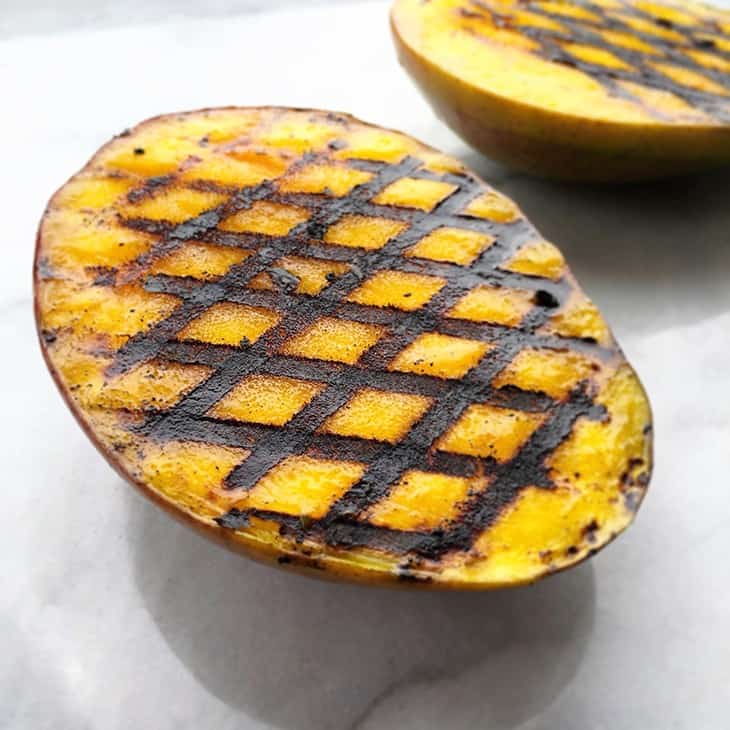
Properly cooked mangoes can give you a fairly similar taste as fired roasted tomatoes. Like tamarind paste, mangoes are already a common ingredient in salads and curry, so they are just a natural alternative when roasted tomatoes are out of the question.
Ripe mangoes are a mixture of sour and sweet flavors, often described as a blend of apricots, pineapples, and peaches.
The buttery texture of ripe mangoes, however, may come too far away from that of fire roasted tomatoes, so it may be a better choice to stick to unripe mangoes instead. They are tart and crunchy, a perfect ingredient for salads and savory recipes.
This tropical fruit is high in folate, a B vitamin needed for red and white blood cells, and a good source of vitamin C, which is vital in anti-aging and tissue repair.
You can find mangoes year-round in groceries and supermarkets, with high availability in early summer. Frozen mangoes in a sealed bag can last for a long time in your fridge, up to six months.
Cut the skin away if you find it too irritating to the mouth, though it isn’t poisonous and can even bring a crunchier texture. Those who are allergic to poison ivy or poison oak should avoid the sap and skin of mangoes. They should use gloves when peeling and cutting into pieces.
Frequently Asked Questions
How to Choose The Best Substitute For Fire-roasted Tomatoes?
The most suitable alternative to fire roasted tomatoes essentially comes down to the recipe you’re making, and in some cases, how far you’re willing to experiment with it.
For example, the texture of chili won’t be much different if you add diced tomatoes instead of the roasted ones. To make up for the lost smokiness, some smoked paprika or smoked salt can be used as well.
Salsa is another dish that goes well with both fire roasted and diced tomatoes. A one-for-one replacement may result in fresher-tasting, brighter, and lighter salsa, while some seasoning will bring back the smoky smell you prefer.
On the other hand, replacing fire roasted tomatoes in meat dishes may be trickier. Fresh or canned diced tomatoes don’t go well alongside the meat’s savory flavor as they would bring an acidic and sharper taste into the recipe.
This is the reason you should stick to similar roasted vegetables like roasted bell peppers. Each of them will offer a unique enhancement to your dish, depending on how you prepare and cook the meat.
Pizzas are quite forgiving when it comes to the smokiness, which you can get from the cooking process anyway. Roasted bell peppers and diced tomatoes are both fine, especially when you can add some caramelized onions or roasted garlic to the pizzas as well.
Tomato paste and puree used in combination with roasted bell peppers have their use in pasta. The roasted peppers will make up for the lost smoky smell, while the tomato paste and puree can add some sauciness to the pasta.
Can I Buy Canned Tomatoes and Roast Them?
If they are whole tomatoes, then yes, you can try to do so.
But keep in mind that these tomato products have plenty of liquid, which you will have to drain out first. These tomatoes are usually already peeled, so be careful with the roasting not to char them beyond the required smokey flavor.
How Many Kinds of Canned Fire-roasted Tomatoes Are There?
Mexican and Italian are the two most popular styles of fire roasted tomatoes, depending on the seasoning you add before roasting. While in Mexican cuisine, you need chili powder and oregano, garlic cloves and rosemary sprigs are what make the distinct flavor of Italian fire roasted tomatoes.
Final Words
When fire roasted tomatoes are not in your pantry, there’s no need to change your recipes. It’s not an excuse when you have one of those substitutes above available.
Each substitute for fire roasted tomatoes above might not be a perfect replacement on all occasions, but there are times you still could have the distinct smoky flavor brought out of your dishes.

